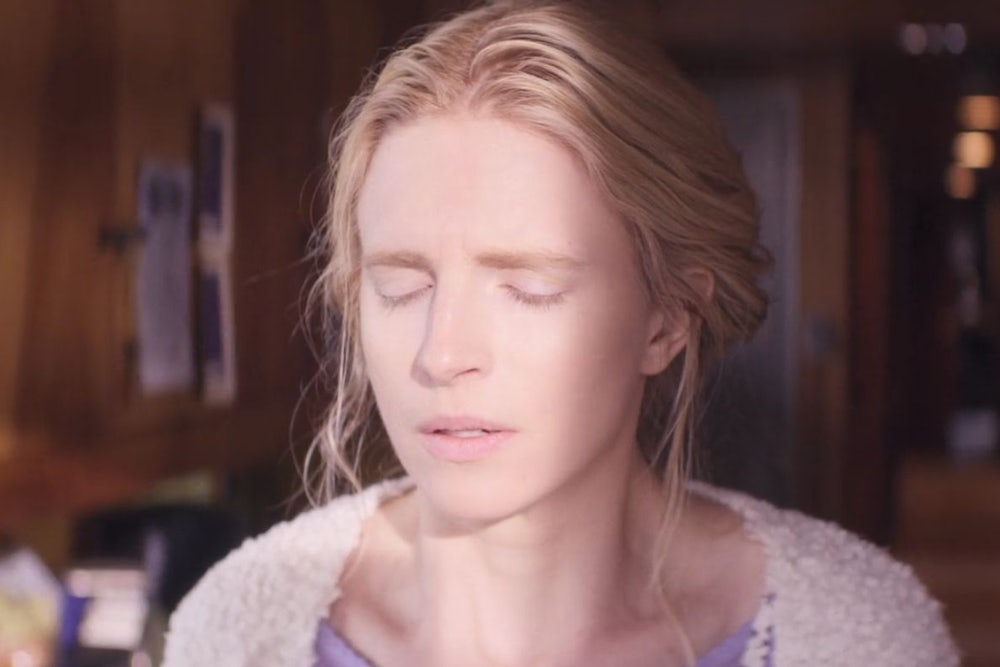In his allegory of the cave, Plato teaches that we cannot truly know things through the evidence of our senses. The new Netflix mystery drama The OA argues the same. Plato’s allegory has haunted us for two and a half millennia and The OA two and a half weeks, but they speak to one another nonetheless.
The OA’s protagonist is a woman who calls herself just that—the OA. The show starts with her being returned to her home after going missing seven years earlier. At first, neither the viewer nor the OA’s family have any idea what kind of ordeal she has suffered. But we do know that the OA left home blind and came home sighted. Our sordid wish to know her secrets propels the show, and the OA’s story plays out in a series-long flashback as she tells her story to a crew of five local misfits.
Those misfits are a boorish teen miscreant and his bowlcut sidekick, two good boys from the same school, and the splendid Phyllis Smith in the role of schoolteacher. The gang get together at night at a local half-constructed house, where the OA tells them what happened to her. It’s important that they gather there, because the OA has a special job for them. Her link to this motley crew is another of the show’s mysteries. Why does the OA affect these people so deeply? Is the connection one of charisma? Prophecy? Religion?
The OA marches onto our MacBook screens like an inverted Tiresias. That seer of Greek mythology was blinded for different reasons according to different literary sources, but in all the stories the gods took Tiresias’s sight because he saw what he should not have. Despite his loss, Tiresias could see the future. The OA, too, claims to have special knowledge of other dimensions, and the gift of prophecy. Like Tiresias, her fleshly and spiritual sight are connected.
We also discover early on that the OA loves a man named Homer. She is desperate to find him, and he is key to her backstory. But another man called Homer wrote the Odyssey, and in that text the hero descends into the underworld. There, he meets Tiresias, who tells him that he must follow a winding and unpleasant path back home. And while the underworld is a physical place in the Odyssey, The OA’s metaphysics rely heavily on the existence of worlds beyond our own.
Through its neat plays on old storylines—the OA regains her sight, rather than losing it; Homer is the blind prophet’s lover, not her creator—The OA toys with our expectations and with a rich and old narrative tradition. But it’s the OA’s ordeal that elevates these references into something deeply thoughtful. Her secret is that she and several other people (including her beloved Homer) were kept locked up in a psychopath’s basement, hewn out of bare rock.
In Plato’s allegory, three people have been chained up from birth in a cave. They face a wall and cannot move their heads. Behind them is a sort of walkway, and then behind the walkway is a brightly burning fire. As free people travel across the walkway, the shadows of the objects they carry are thrown against the wall beheld by the captives. Since they have never seen anything else, these shadows appear to the prisoners to be real things. Those prisoners who seem to have special insight into the shadows—by, for example, seeming to have predicted which one would float by next—gain special status in the group.
Eventually, one of the captives breaks free and runs away. At first he cannot believe in the “real” world, after his lifetime of shadows. Once he sees things as they are, and realizes that the sun is the world’s lifegiver, he decides to quest after life and truth. The shadows held no real knowledge. The sun represents truth and philosophy. He returns to the cave to free his fellows, but they do not wish to be freed.
As with its treatment of Homer, The OA both reverses and strangely expands upon parts of Plato’s allegory. Much like Plato’s captives, the prisoners understand part of the mysteries confronting them. They can see shapes of ideas. How can they get out? Why are they here? Why does this nutty scientist care about their brains in particular? They see the answers to such questions like half-formed shadows playing against a wall. But as the show unspools, we realize that the captives can only find the truth by turning inward.
Through her special insights, the OA offers the group a way forward: Instead of getting out, as in Plato’s parable, this group must plunge in. Enlightenment is found in their authentic group relationship, as they pursue perfect spiritual connection with one another. Placed beside similar shows that encourage their viewers to think about what it really means to be an individual in society—Westworld, Stranger Things—we can see The OA as part of a new genre of TV sci-fi that evangelizes against our atomized world. These shows promote direct, authentic relationships among human beings. There is no external sun of philosophy in this type of television. Indeed, conventional knowledge and high-flown knowledge only lead away from the truth. The only way forward is through the radical connectivity of the human heart.
By juxtaposing Greek thought with a captivity story featuring a pretty blonde woman, The OA achieves a very strange and compelling textural effect. Its hour-long high-drama “Netflix event” styling recalls true-crime drama like the recent documentaries about JonBenet Ramsey and Amanda Knox. These cues lure the viewer by promising the sordid details of the girls’ ordeals, playing on our fears for ourselves and our prurient wish to know about others’ suffering. But The OA gradually reframes this voyeuristic lust for information into a quest for knowledge, one that is modeled on the oldest exempla in our canon.
